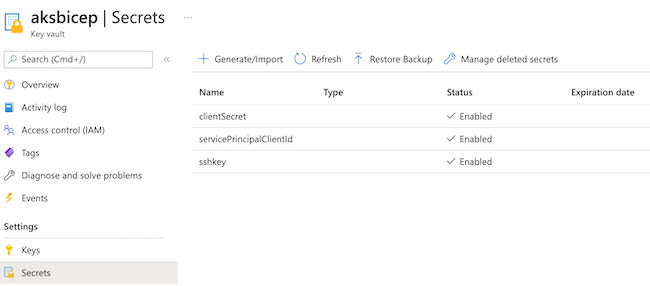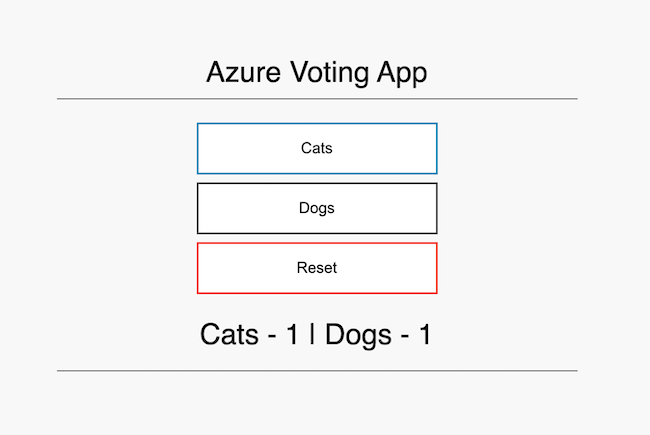An example to create an AKS cluster with secrets from Azure Key Vault with Bicep and GitHub actions. Once the cluster is created, the workflow will apply manifests/deployment.yml that's a pre-created image.
Bicep is a domain-specific language (DSL) that uses declarative syntax to deploy Azure resources. It provides concise syntax, reliable type safety, and support for code reuse. We believe Bicep offers the best authoring experience for your infrastructure-as-code solutions in Azure.
GitHub Actions helps you automate your software development workflows from within GitHub. You can deploy workflows in the same place where you store code and collaborate on pull requests and issues.
Azure Key Vault protects cryptographic keys, certificates (and the private keys associated with the certificates), and secrets (such as connection strings and passwords) in the cloud.
Azure Kubernetes Service Easily define, deploy, debug, and upgrade even the most complex Kubernetes applications, and automatically containerize your applications. Use modern application development to accelerate time to market.
-
An SSH public key.
-
Fork this repository so you can run GitHub Actions
-
Clone the fork locally or in your Azure Cloud Shell.
- Create an Azure Resource Group
az group create -n <rg name> --location <region>
- Get your subscription ID
az account list --query "[?isDefault]"
- Follow the "Generate deployment credentials" and "Configure the GitHub secrets" of this guide. Create secrets in the repo for
AZURE_CREDENTIALS,AZURE_RG, andAZURE_SUBSCRIPTIONto connect your Azure account to the GitHub repo for actions to run OR use the CLI commmands below.
az ad sp create-for-rbac --name {myApp} --role contributor --scopes /subscriptions/{subscription-id}/resourceGroups/{MyResourceGroup} --sdk-auth
az keyvault create --name "<your-unique-keyvault-name>" --resource-group "myResourceGroup" --location "EastUS"
- Store your credenitals
sshRSAPublicKey,servicePrincipalClientId, andservicePrincipalClientSecretparameters as secrets. These secrets will have your SSH keys to access the cluster nodes for troubleshooting, your Azure subscription ID, and your Service Principal credentials.
- Update azuredeploy.parameters.json with
uniqueclustername,dnsPrefix,sshRSAPublicKey,servicePrincipalClientId, andservicePrincipalClientSecretdetails.
"id": "/subscriptions/{subscriptionID}/resourceGroups/{resource group}/providers/Microsoft.KeyVault/vaults/{keyvault name}"
Set the environment variables on the .github\workflow.json file to your cluster name, resource group, kubernetes namespace, and application name.
Example:
CLUSTER_NAME: voteappprod
CLUSTER_RESOURCE_GROUP: aksbicep
NAMESPACE: voteappprod
APP_NAME: voteappprod
When you commit to the main branch, it will kick off a build. You'll get an AKS cluster with a service principal. You can add custom names and features to the parameters file.
Finally the manifests/deployment.yml file is loaded which provides you with the Azure Voting App, a Python/Flask app with Redis as your data component.
To access your public IP from the loadbalancer:
az aks get-credentials --name voteappprod --resource group <resource group name>
kubectl get services --all-namespaces
Your output should be something like this:
NAMESPACE NAME TYPE CLUSTER-IP EXTERNAL-IP PORT(S) AGE
default kubernetes ClusterIP 10.0.0.1 <none> 443/TCP 47h
kube-system healthmodel-replicaset-service ClusterIP 10.0.228.13 <none> 25227/TCP 47h
kube-system kube-dns ClusterIP 10.0.0.10 <none> 53/UDP,53/TCP 47h
kube-system metrics-server ClusterIP 10.0.212.100 <none> 443/TCP 47h
voteappprod azure-vote-back ClusterIP 10.0.62.6 <none> 6379/TCP 47h
voteappprod azure-vote-front LoadBalancer 10.0.19.38 1.2.3.4 80:30305/TCP 47h
You can execute the following command in the root of the directory with an autheticated Azure CLI.
This example creates a resource group then creates a deployment with ARM.
az login
az group create -n <resource group name> -l <location>
az deployment group create --name <deployment name> --resource-group <resource group name> --template-file aks.bicep --parameters='@azuredeploy.parameters.json'
az aks get-credentials --name voteappprod --resource group <resource group name>
kubectl apply -f ./manifests/deployment.yml


